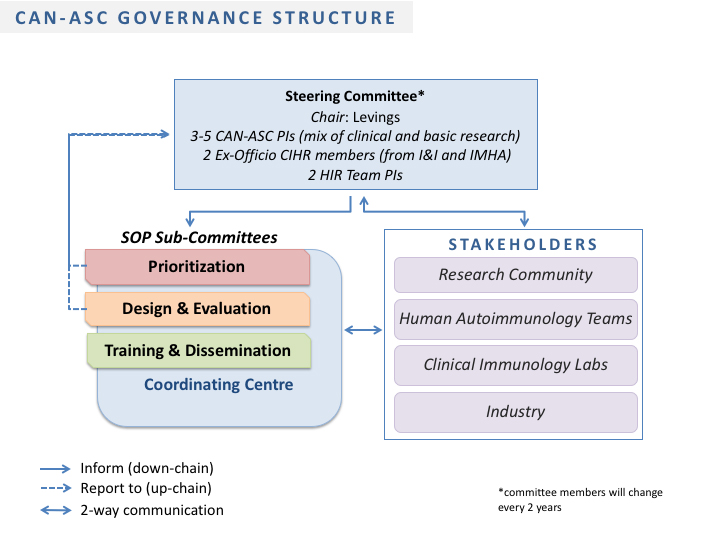For an overview on CAN-ASC, visit our About Us page.
The CAN-ASC Governance Structure includes:
- Steering Committee (which includes ex officio representatives from CIHR)
- Coordinating Core
- 3 Sub-committees
- SOP Prioritization Committee,
- SOP Design & Evaluation Committee
- Training & Dissemination Committee
- a mechanism for regular communication with stakeholder
As the overall lead and chair, Dr. Megan Levings (NPA) will have ultimate responsibility for financial, programmatic, strategic planning and decision-making, and for reporting to CIHR.

The Steering Committee
The Steering committee will make decisions about the overall scientific direction. They will conduct an annual review of progress towards major objectives and evaluate Subcommittee activity. They will also approve any new partnerships (e.g., with industry), evaluate potential conflicts of interest and provide the final recommendations about any programmatic changes to CAN-ASC.
The committee will comprise:
- the Chair (Levings)
- 3 CAN-ASC leads, mix of clinicians and basic scientists
- 1 sex and gender expert
- 2 CIHR ex officio members
- 2 Human Immunology Research (HIR) team leads
All positions except for the chair will rotate every 2 years. They will meet on a quarterly basis.
CAN-ASC Coordinating Core
This core will be based at the BC Children's Hospital Research Institute (BCCHRI). The Coordinating Core includes a Project Manager (Ivison) and Administrative Manager (Li) who will report to Levings. They will take an active role in the CAN-ASC subcommittees to facilitate the entire assay identification, design, testing, and dissemination process, communicate on a regular basis with CAN-ASC Reference and Test Labs, as well as with the CAN-ASC statistician. The Coordinating Core will also organize travel awards and hands-on workshops.
CAN-ASC Subcommittees